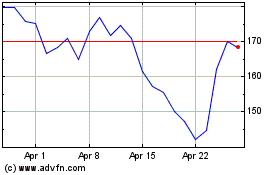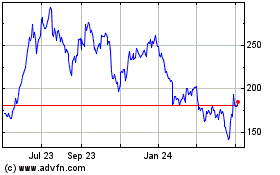By Tim Higgins
Tesla Inc., for the first time in its 17-year history, reported
a fourth-consecutive profitable quarter, a milestone that is sure
to bolster Chief Executive Elon Musk's pitch that he can usher in
the age of fully electric cars.
Defying the global coronavirus pandemic, threat of extended
economic recession and Wall Street analysts who expected a loss,
the Silicon Valley auto maker found a way, helped by the sale of
regulatory tax credits, to eke out a $104 million profit in the
second quarter.
On an adjusted basis, excluding stock-based compensation, the
company said Wednesday it made $2.18 a share. Analysts surveyed by
FactSet, on average, expected an adjusted loss of 2 cents a share
earlier in the day, an estimate that narrowed from a loss of 14
cents on Monday and a much larger projected loss in May.
Shares soared more than 5% in after-hours trading in New
York.
During a call with analysts, Mr. Musk said Tesla had picked a
location near Austin, Texas, for its second U.S. assembly plant,
where it will build a pickup and a semitrailer truck, as well as
Model 3 and Model Y compact vehicles for the Eastern U.S.
Tesla's ability to meet its pre-pandemic goal of delivering more
than 500,000 vehicles this year, a more than 36% increase from last
year, remained vague. The company pulled back slightly, saying that
its target remained to deliver 500,000 vehicles. But it added that
achieving that goal had become more difficult. It declined to
comment on the goal in late April, when Mr. Musk was railing
against California authorities for keeping his lone U.S. assembly
factory outside of San Francisco closed as part of an effort to
stop the spread of Covid-19.
"Although we have successfully ramped vehicle production back to
prior levels, it remains difficult to predict whether there will be
further operational interruptions or how global consumer sentiment
will evolve in the second half of 2020," the company said. "We will
continue to update our outlook as necessary."
The achievement of four cumulative quarters of profitability
means Tesla can now be considered for inclusion in the S&P 500
index. If included, large index funds would likely race to include
the shares among their holdings.
It also signals that an electric car company can do what many in
the auto industry thought unlikely when Tesla was founded years
ago: make money on an electric car. Though fun to drive, they were
seen as too costly to make because of expensive batteries that
power the motor.
"A roadway into the S&P 500 is kind of ordaining Tesla a
real company and that always wasn't the case," Gene Munster,
managing partner at investment and research firm Loup Ventures,
said. "That's why it's a historic day."
Reaching this point hasn't been easy. Tesla has lost more than
$6.78 billion since 2003 and neared financial collapse on several
occasions, including in 2008 and 2018 as the company struggled to
bring out the Model 3, Mr. Musk's long-held vision for how he would
pivot the company from niche luxury cars into a mainstream
player.
After losing $408 million in the second quarter a year ago, he
appeared to turn a corner in the second half of last year as the
Model 3 fueled massive growth and after Tesla successfully opened
its first overseas assembly factory in China.
That factory and its lower labor costs played an integral role
in the second quarter, allowing the company to continue to churn
out cars, even as its U.S. assembly plant was closed for about half
of the period. The company has also worked to slash costs amid the
pandemic: cutting salaries, furloughing workers and seeking rent
breaks.
Analysts were braced to write off the quarter, even as they held
out hope that Tesla could rebound in the second half and turn a
full-year profit. But on July 2, after a hard manufacturing and
sales push, Tesla reported deliveries for the period fell just
4.9%, beating expectations for a 24% slide.
Revenue fell 4.9% in the quarter to $6 billion, as Tesla relied
on selling less expensive vehicles. The results were helped by $428
million in revenue from the sale of regulatory tax credits to
competitors, which essentially goes straight to the company's
bottom line and has been an important way the company has eked out
profits in the past. A year ago, the company earned $111 million
from those credits. It also unlocked $48 million in revenue from
deploying software features through its so-called Full Self-Driving
driver-assist system.
Tesla may not be able to depend so heavily on those credits in
the second half of the year. Chief Financial Officer Zach Kirkhorn
told analysts the company's total revenue from the credits would
likely be about twice as much as in 2019 when the company reported
$594 million. In the first half of this year, Tesla has already
recorded $782 million from those credits.
"It simply boggles the mind that the most valuable auto company
in the market has to resort to these accounting games to even show
any profit," short seller David Rocker, a retired hedge-fund
manager, said.
The delivery results buoyed a stock surge that has seen Tesla's
share price nearly quadruple this year, helping the company unseat
Toyota Motor Corp. as the world's most valuable auto maker.
The math behind that valuation is hard for many longtime
observers of the auto industry to comprehend, and some investors
continue to bet that Tesla is overvalued and will face a coming
reckoning.
The run-up in the stock this week has qualified Mr. Musk for the
second tranche of a 12-part compensation package worth more than
$50 billion tied to operational milestones and market value. He
qualified for the first stock vesting in May after the company
maintained a market value of $100 billion. The shares at that time
would have nominally netted him more than $700 million if he sold
then, which he couldn't.
The final requirements for the second tranche of 1.69 million
shares were reached this week, with the market value staying at
$150 billion on average for six months and 30 days, and would be
worth $2.1 billion at Wednesday's closing share price minus the
$350.02 strike price he would need to pay.
Write to Tim Higgins at Tim.Higgins@WSJ.com
(END) Dow Jones Newswires
July 22, 2020 20:45 ET (00:45 GMT)
Copyright (c) 2020 Dow Jones & Company, Inc.
Tesla (NASDAQ:TSLA)
Historical Stock Chart
From Mar 2024 to Apr 2024

Tesla (NASDAQ:TSLA)
Historical Stock Chart
From Apr 2023 to Apr 2024
